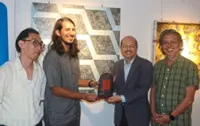'I am a firm believer that an artist has to be observant even about the simplest things in life, for these images make great stories,' says Mohd Azlan Mam Mohd Latib, an experimental photographer. Photo: The Star/Chan Tak Kong
Walking into a storeroom that doubles up as an art studio at the Radiology Department of the Cardiac Vascular Sentral Kuala Lumpur (CVSKL) feels like stepping into a resistance hideout during a post-nuclear holocaust.
The walls of the small room are plastered with A4-sized pieces of art – sepia toned, with splotches of red, images of men in gas masks, and motifs of hearts and lungs jumping out to grab one’s attention.





